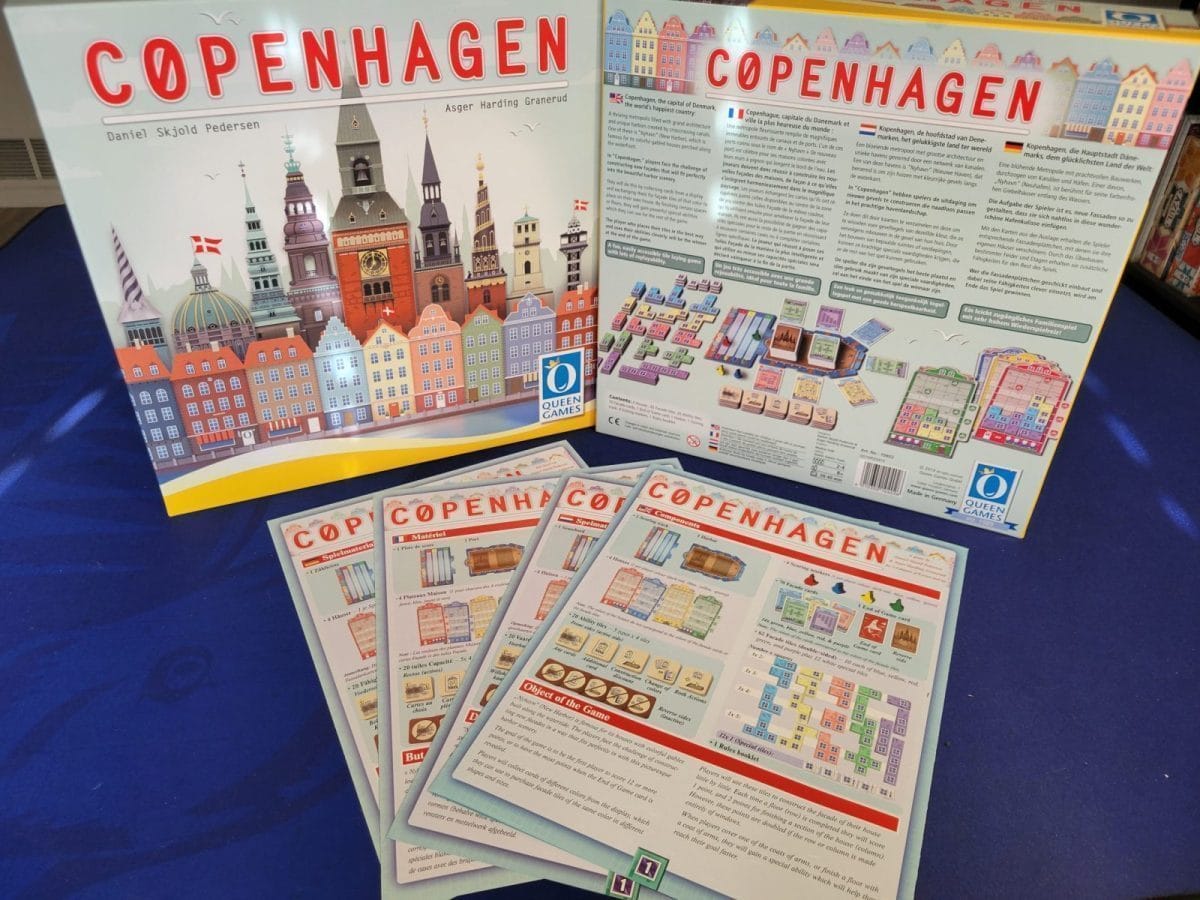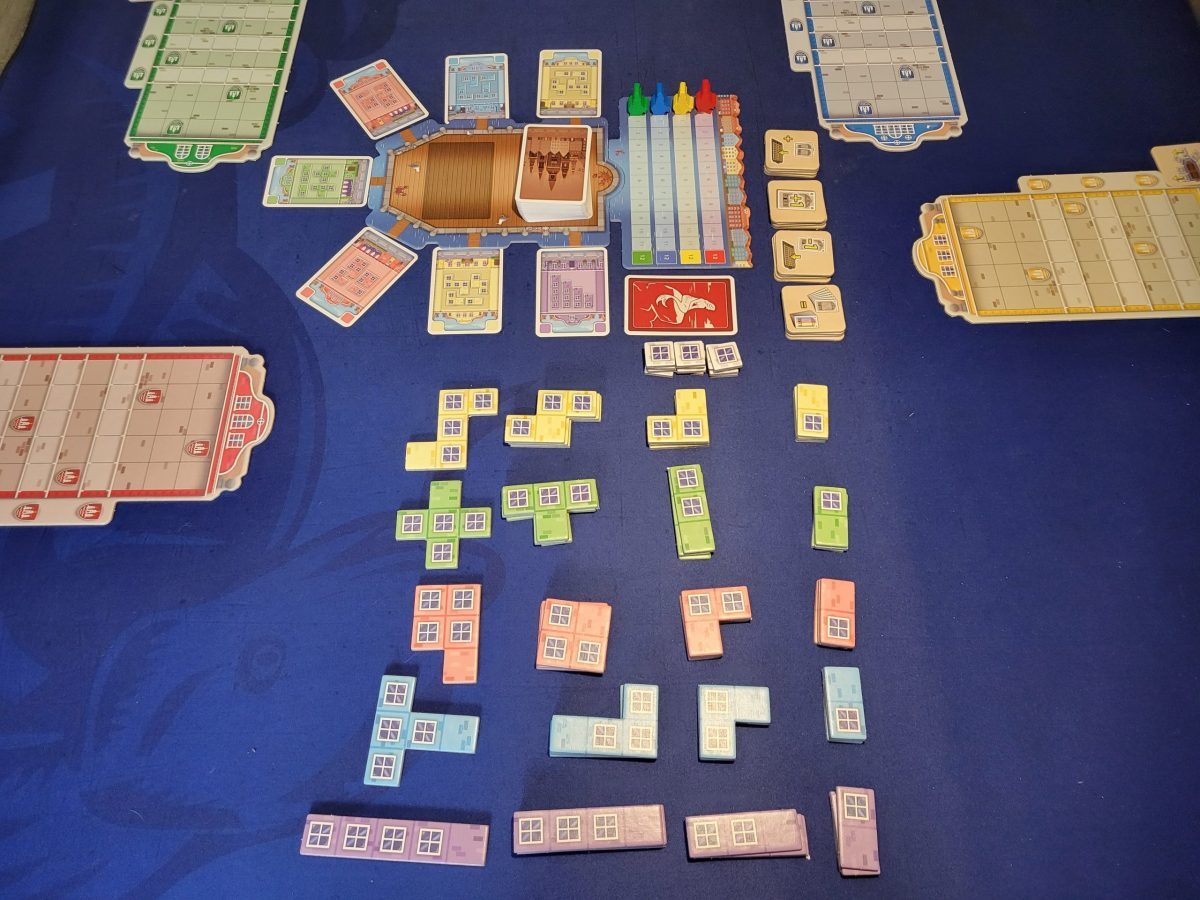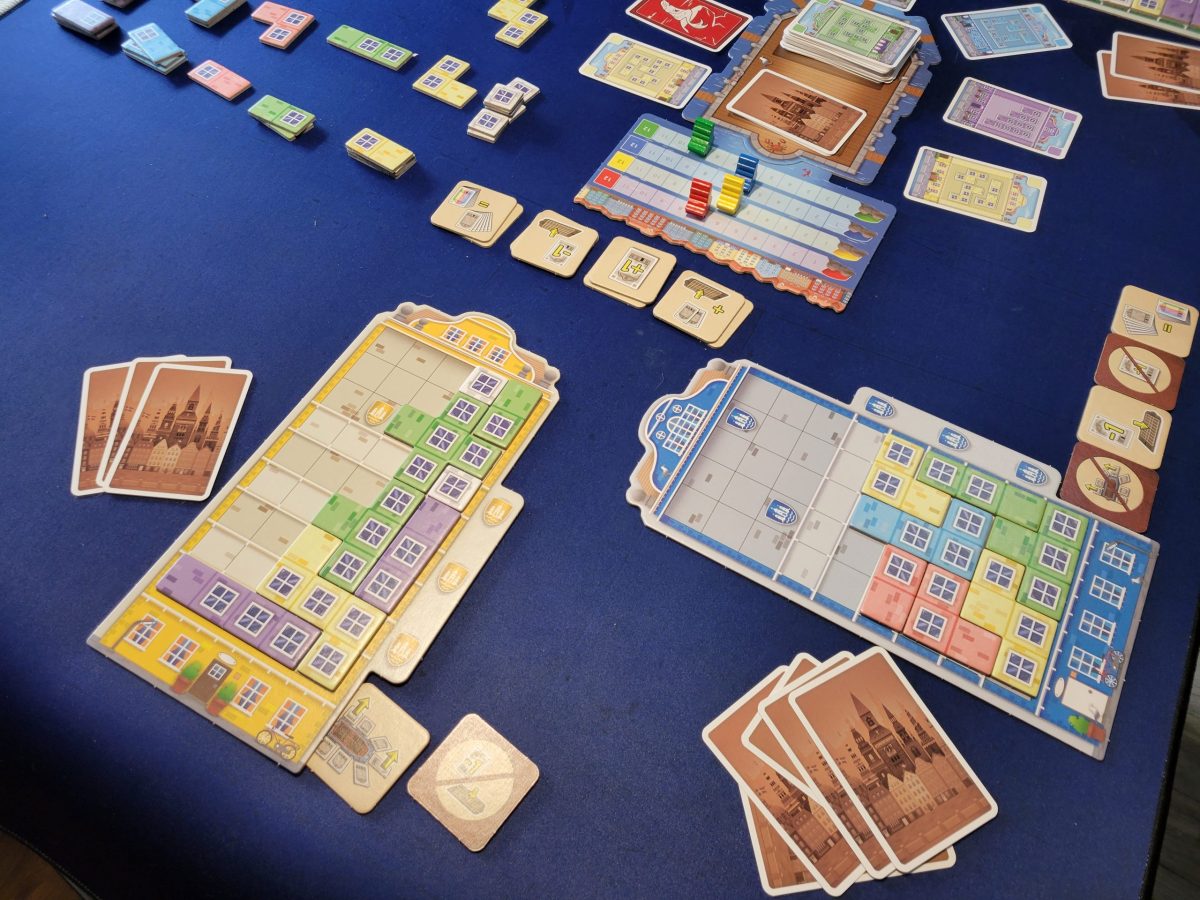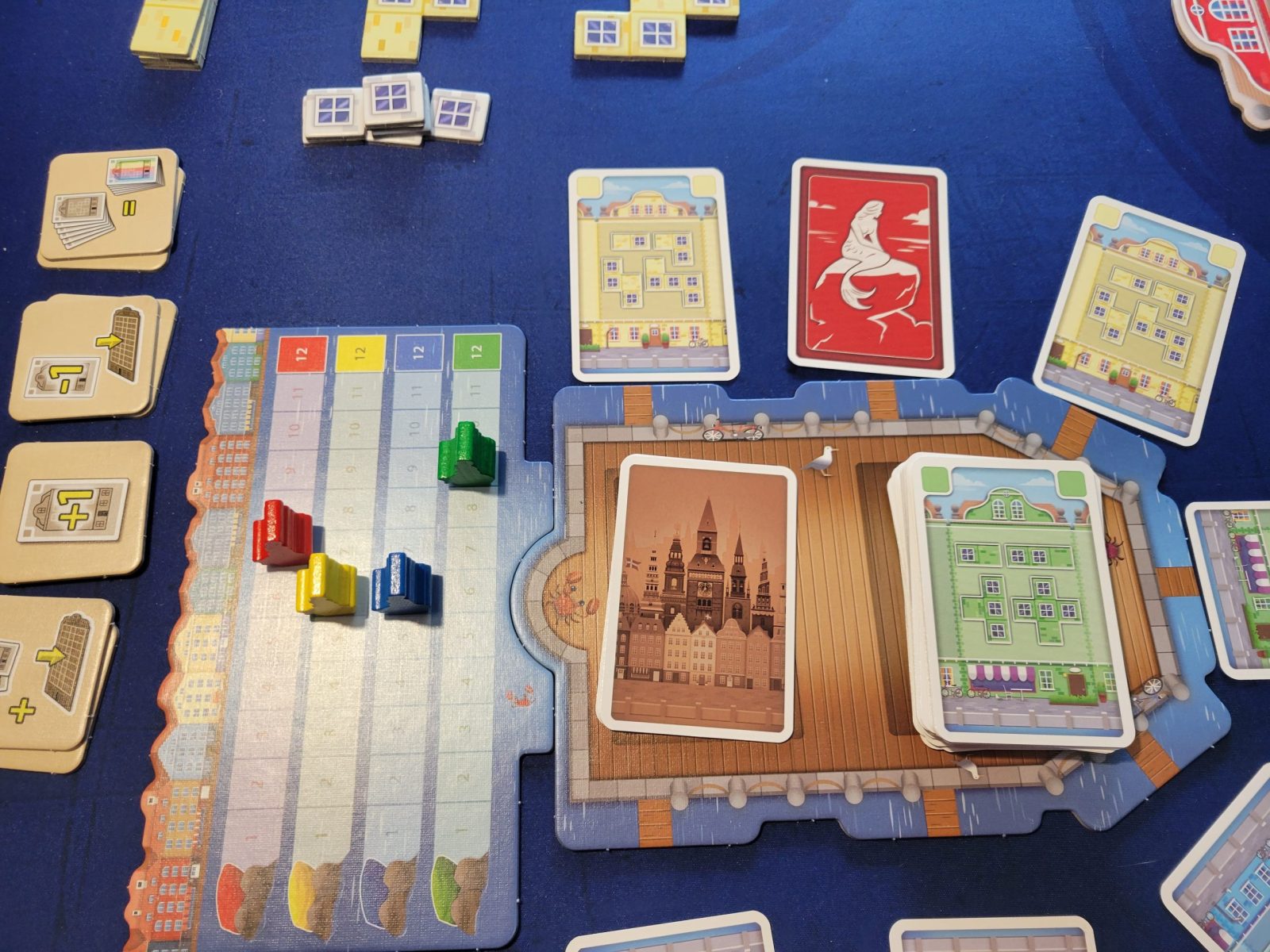
The city of Copenhagen, Denmark, is known for its peaceful canals, sprawling harbors, and the colorful homes that line the idyllic waterways. By comparison, the board game Copenhagen, designed by Asger Harding Granerud and Daniel Skjold Pedersen and published by Queen Games, falls a little flat. The game proclaims to have players take on the role of re-designing the facades of buildings lining the waterways of Copenhagen, adding flairs of bright colors that will blend seamlessly into this beautiful setting. In game play, it offers none of this theme and drowns the player in simple, at times almost boring, decisions as they race to be the first player to score twelve points and invariably fail to complete the facades they are alleged to be building. It is not that the game is unenjoyable, and it certainly has its place as a family-weight game, it just lacks a hook which would make players want to return to the game for future plays.
In the game, players will take turns completing one of two actions; collecting cards from a market row or spending matching color cards to purchase polyomino tiles to add to their building’s façade. The goal of the game is to be the first person to reach twelve points, or to have the most points when the “mermaid card” is revealed from the deck (apparently this is a reference to a famous statue of The Little Mermaid in Copenhagen, but I had to Google this to find that out). Points are earned by filling rows or columns on a player’s board, i.e. the façade they are working on. One point is earned for each completed row, while each completed column earns two points. However, the tiles players will be using to complete their façade will always come with one space containing brick works and one or more spaces with a window, if all of the spaces in a row contains windows it is worth two points, and columns which contain all windows are worth a whopping four points (one third of the points required to win).

Copenhagen starting set up.
In order to purchase the tiles used to complete their façades, players need to collect cards of a matching color. Throughout the game there are seven cards on display in a market row, and as an action a player may select two cards from the market that are adjacent to one another to add to their hand. A player can hold a maximum of seven cards in their hand at a time and must immediately discard down to seven if they ever have more cards in hand. Cards come in five different colors, and each color corresponds to the tiles of that same color.
To purchase tiles to add to their façade, the player must spend between two and five cards of the same color. The number of cards spent will determine the size of the tile being purchased in that color. For example, spending four blue cards will allow a player to purchase a size four blue tile. Each color corresponds with a different set of polyomino shaped tiles so the color spent can dictate how a tile is placed onto a player’s board. Additionally, if a tile being purchased touches another tile of the same color already on the player’s board, the player may pay one fewer card to purchase that tile. Placing these tiles on the player’s façade follows simple Tetris rules, a tile can be rotated in any way or even flipped on its axis, it must be placed on the bottom row or with at least one square directly on top of a previously placed tile, it cannot overhang the player board and cannot overlap another tile.
The final mechanic of note in this game (and arguably the games saving grace) is the coat of arms spaces found on each player board. On each board there are four spaces with a coat of arms and an additional three coat of arms to the side of the player board that correspond with a particular row. Each time a player covers a space containing a coat of arms or completes a row with a coat of arms next to it, they gain a special action. There are three types of special actions that can be chosen, a player may choose to take a free single square tile which contains a window and immediately add it to their player board (if this tile would cover another coat of arms or complete an associated row, then the player may immediately chain this into another bonus action). A player may choose one of four special ability tiles (there are five in the game but everyone starts with one), which are single action tiles which allow the player to break the rules for one turn in various ways, or the player may refresh all of their used ability tiles so that they may use them again on a future turn.

Player boards mid-game of Copenhagen.
Ultimately, Copenhagen is a pleasant game that doesn’t take itself too seriously and does not overstay its welcome. It is on the lighter end of the scale and is a decent family weight game with a recommended player age of eight and up, and this is where I think this game shines, as a gateway game or something to play with younger players. There are some great educational components that can teach young kids’ spatial awareness, strategic planning, and basic math. It also holds up as a way to introduce new hobbyists to some common tabletop board game mechanics, such as tetromino tile placement, hand management, and comboing effects. Because all these mechanics are distilled down to their most basic form, Copenhagen becomes a good introductory game.
Where Copenhagen fell flat is its near complete lack of re-playability, poor luck mitigation, and bizarre disconnect from its stated theme. There is very little to explore in Copenhagen short of learning how to combine gaining and using the special ability tiles to try and rush to the twelve points needed to end the game. After a half dozen plays of the game at varying player counts, there was nothing that stood out from one game to the next or any depth of strategy to explore. Meanwhile, each turn is completely beholden to the card market and there are very few opportunities for you to mitigate what is available in the market. While there are a few special ability tiles that interact with the market, there are only a handful of times throughout a game where you will have access to this type of mitigation. What this results in is a game where the strategy is in figuring out how to work within the strict confines of the pure luck of the card draw you are beholden to.
What really brought me down on this game though is the disconnect between the game play and the theme. While I am typically very forgiving of a themeless game, or a game that simply pastes theme on as an afterthought, there needs to be a lot more meat on the bones from a mechanics perspective than what Copenhagen offers for me to give that pass. For a game that is purportedly about building beautiful building facades, what you are typically left with at the end of this game is a building that resembles more of a random hodgepodge of varying colors of tetromoino pieces that is far from beautiful. While the game encourages you to utilize tiles of the same color by giving you a discount for matching tiles, the lack of market manipulation can make that a purely luck dependent endeavor as you search for the same-colored cards that just aren’t coming out. Worse still, with nine rows and five columns to fill, it is almost impossible to actually complete the building of your façade without hitting 12 points first, let alone doing it before the mermaid card is drawn from the deck. This leaves players feeling unfulfilled and just isn’t a satisfying way to end a game while furthering the disconnect between theme and mechanisms.
Finally, there is the component quality. For this review I was able to play the base copy of the game which contains cardboard tiles and single layered player boards. Queen Games may not be known for high quality components but I think it could have been done better here. The single layer player boards mean that tiles can have a tendency to be knocked around or slide off the board, and the tiles themselves feel a little lackluster. For a game that is all about beauty and color, the tiles are a little dull and washed out, creating even more disconnect from the theme. There is a deluxe edition of Copenhagen out there with acrylic tiles which do look much nicer, but with the base game already coming in at a $60 MSRP, I would be hard pressed to recommend spending even more on this game for those tiles.
Copenhagen
All Right
If you are looking for a light weight, simple, tetromino style of game then Copenhagen would be a great addition to your collection, especially if you have younger kids who enjoy playing games and don’t mind a lack of theme. Beyond that though I think you could probably pass on this game. It is perfectly fine, and if someone asked me to play it I would and would likely enjoy my short time with it. It is just not something I am clambering to get back to the table and with so many truly great games on the market today that is a death nail for a game staying in my collection.
Pros
- Simple to teach and learn
- Basic mechanisms make it a perfect gateway
- Short play time makes it a good filler game
Cons
- Simple mechanisms leave little room for depth
- Heavily luck dependent with minimal mitigation opportunities
- Deep disconnect between theming and game play mechanisms / components
